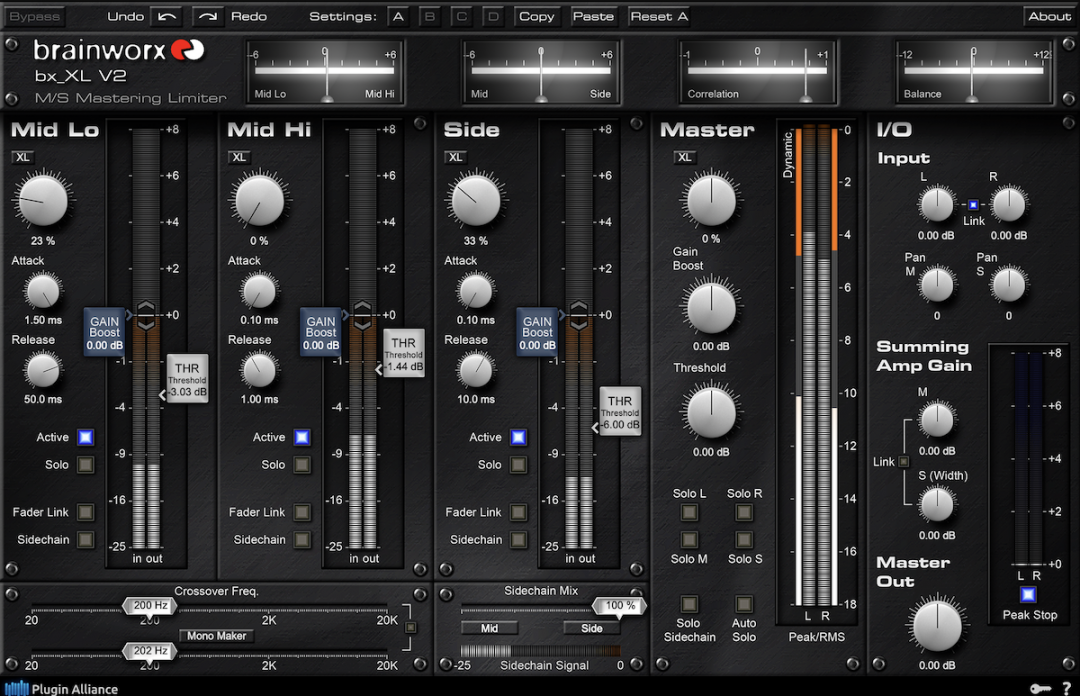Mid/side processing is a means of further separating stereo information for detailed control while mixing or mastering. The mid channel contains information we perceive as the center, which is actually the sum of the left and right channels. The sides contain whatever sounds are unique to their respective channel.
What is mid/side processing?
At face value, mid/side seems like a modern marvel—something only achievable with fancy plugins in the digital world. However, mid/side processing owes itself to the work of Alan Blumlein in the 1930s, an EMI engineer known for his eponymous microphone technique.
Blumlein patented the theoretical backbone for mid/side, while Danish engineer Holger Lauridsen invented the mid/side microphone technique in the ’50s. We won’t delve into the details of the mic setup, but it requires a particular arrangement as well as a matrix on a console or in a DAW to decode the information correctly.
Another way to think of M/S processing is ‘sum’/’difference.’ The mid information is the sum of everything that’s equal between the left and right channels. The sides contain everything that’s different between both channels. It’s critical to note hear that M/S does not offer perfect separation between these channels! Without getting into the math of M/S matrix encoding, in practice, even instruments panned hard left or hard right will actually end up in the mid section. It’s very important to understand this before you start applying heavy-handed mid/side processing.
Mid/Side Tips for Mixing & Mastering
Mid/side processing is incredibly powerful. Generally speaking, subtle is the way to go with M/S. It’s sort of like multiband compression in the sense that it can get out of hand really quickly!
One thing it’s great for is controlling the width and spaciousness of a mix or instrument, and that’s fundamentally the most common type of mid/side processor: one that lets you change the volume of either channel. You could turn up the sides for more apparent space on an instrument, or turn up the mid to bring a vocal forward, for instance. On a guitar part, for example, you could automate mid/side processing to boost the side information on a chorus to make it sound bigger.
- SEE ALSO: Decoding Mid/Side Miking Techniques
Across an entire mix you could throw on a M/S EQ, and boost the low-mids and highs on the sides. That will increase the perceived width of the track without making the center muddy with extra low-mid information.
Another popular use of M/S processing is to make the bass mono. It’s sort of an unwritten standard that low-frequency instruments like kick drum, bass, synth bass, etc. should stay in the center of a stereo mix. Using a mid/side EQ, put a low-pass filter on the sides to remove any upper harmonics, leaving just frequencies around 700 Hz and below. That effectively makes the bass mono below 700 Hz, focusing the energy in the center. That’ll also create more room for everything else in the mix.
If you’re mastering a muddy mix overall, you can try reducing the low frequency content on the sides with M/S EQ. M/S compression also comes into play for mastering. Sometimes we have a lot of stuff happening in the center of a mix that hits a mastering compressor really hard and squashes the whole thing. Try compressing the sides less than the mid part; you can still tame the mid section with ample compression, but also retain width and spaciousness by not squashing the sides along with it.
Keep in mind, you have to be pretty careful with mid/side processing, especially whenever you’re doing something on a global mixing or mastering scale. Think about it like this: if we know that even hard-panned elements end up in the both the mid and sides, any sort of processing you do is going to treat that element twice (and differently). That could potentially create some really weird and unwanted effects.
Bonus: How to Isolate Vocals with Mid/Side Processing
For whatever reason you may want to isolate vocals on a mix, you can do it with mid/side processing. Most M/S EQs will let you solo the mid or the sides individually, so start by soloing the mid section. From there you can filter everything around the center of your vocals; usually you’ll find the middle of your vocals’s range around 2 kHz.
You’ll be left with the vocals and bits of other instruments in the mix. It might be a fun experiment to reference the vocal sound by itself on mixes you love!
